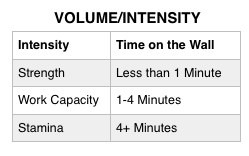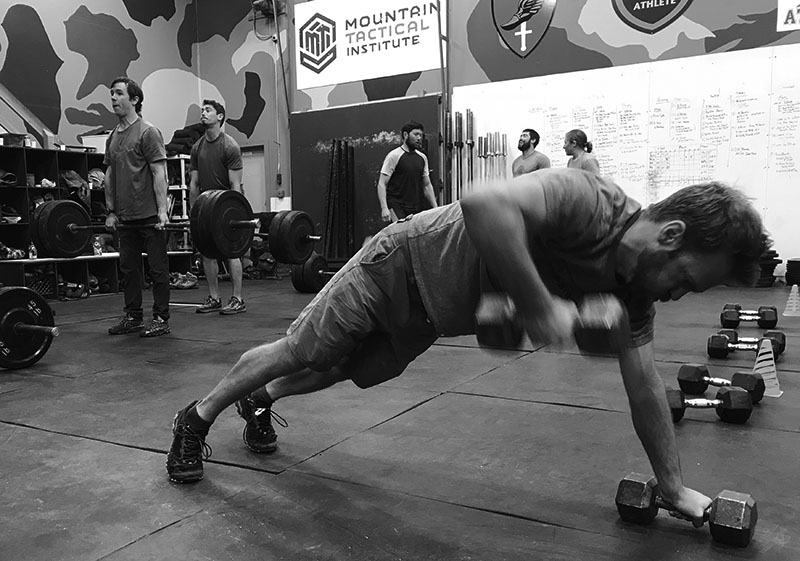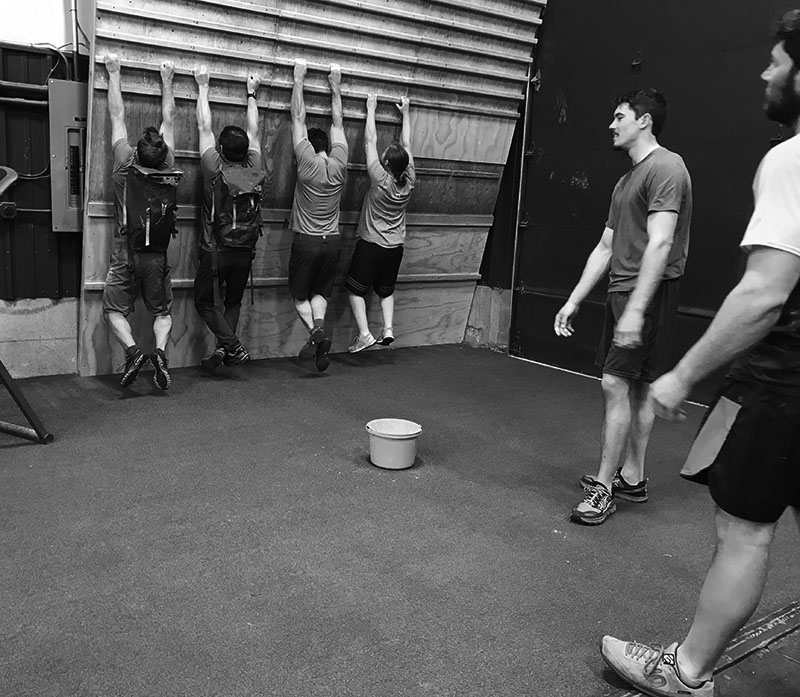
By Rob Shaul
Founder/Coach
Background
One of my earliest mistakes as a strength and conditioning coach was trying to use general fitness programming to prepare local rock climbers for their annual Spring Break climbing trips to the desert Southwest.
This was my first year as a coach with my own gym here in Jackson, and at the end of that cycle, boy were my climbers good at squats, burpees, swings, sprints, pull ups – you name it. They trained hard and heavy for an intense 6 weeks.
And boy were they mad at me upon return from their climbing trips to Utah and California. It turns out that burpee fitness does not transfer to the very narrow, sport-specific finger and grip strength deployed for rock climbing. Immediately I purchased every book on rock climbing training and program design I could, and began reading and testing. I invested in some system boards in my gym for sport-specific programming and things have progressed on and on from there.
As a strength and conditioning coach, I’ve learned that good sport-specific program design really begins with a knife. Identify what the fitness demands of the sport or event are, which exercises you have available in the gym to train them, and focus on what transfers by cutting out the extra stuff.
This focus and cutting takes confidence and experience and continues to this day.
What is Climbing Fitness?
Ninety-five percent of climbing fitness is finger/grip strength related. Upper body pulling strength is far less a determinate of climbing ability than one might think. We’ve seen this many times – women who struggle with simple pull ups, regularly outperform men on our system boards and out climb men on actual rock.
Body tension is another component of climbing fitness I’ve honestly struggled to identify, and similarly struggled to find progressable, gym-based exercises to train. On actual climbs, you’ll see body tension come into play when reaching for wide holds, or for contact strength on small holds or slopers. Some coaches use levers to train this, but I’m not convinced of the transfer to the actual sport. As a whole, however, body tension is not nearly as important to finger/grip strength for climbing performance.
As well, Base or general strength and fitness is not super important. We’ve had world class, national champion climbers in our gym for photo shoots, who struggled with simple push ups and squats, could barely do sprints or any cardio, and smoked cigarettes outside between photo sets! But their fingers had re-bar like strength, and their forearms rivaled Popeye’s. They onsighted the hardest bouldering problems in the local climbing gym, no problem.
“Intensity” applied to Rock Climbing
To understand this concept, I need to take you to the gym and use a barbell example.
In strength and conditioning terms, “intensity” means the load on the barbell.
The heavier the barbell, the higher the “intensity.”
And, if you’re just doing regular reps, the heavier the barbell, the few reps you can do, and thus, the less time you have under load, or ” tension.”
In my programming for climbing, I’m applied this “time under tension” to programming.
See the chart below:

Understand for time what I mean here is how long the athletes are hanging on their fingers/grip.
Strength efforts are short, hard and intense. We can use both timed intervals and campus dyno and lock and reach reps for progression. More and more I find I use the campus boards for our rock climb training.
Work capacity events are perhaps the most painful for our lab rats. These longer intervals on the wall should end intensely for the athletes. Often our athletes will be “chicken winging” – fighting to stay on at the end of the interval – you’ll see some of this in the videos below.
Stamina efforts are much longer, but not nearly as intense. In general fitness terms, these should feel like a long easy or moderately paced distance run.

Spring 2018 Rock Cycle Design
In the past year, we’ve purchased a new rock climbing training tool in my gym – a Moon Board. Developed in the UK, the Moon Board standardizes holds and hold placements, and uses lights and a smartphone app for creating an unlimited number bouldering problems of different grades in a very compact space.
Rock climbers have a constant, shifting imbalance between climbing fitness and climbing technique.
Brand new climbers have a wide imbalance – they are plenty strong for the low rated climbs, but are limited by technique.
But soon, technique catches up, and the imbalance between fitness and technique becomes much more narrow.
Experienced climbers constantly battle this imbalance, not only in their general terms but also on specific bouldering problems or routes.
Until our Moon Board purchase, I really had no way to train “technique” in my facility – so our past cycles have focused purely on fitness.
Our Moon Board has allowed me to deploy perhaps my favorite Rock Climbing training event – the Bouldering V-Sum.
The Bouldering V-Sum is a super efficient and enlightening way to train both rock climbing technique, and climbing fitness strength concurrently. For this cycle, I deployed a 6-problem V-sum on a 50-minute timer. After a short 5-minute warm up on the system wall, my climbers had 50 minutes to work boulder problems on the Moon Board. At the end of the 50 minutes, they added up their top 6 problems for that days’ V-sum. The goal was to have the V-sum’s continue to improve/increase over the course of the cycle.
The Moon Board gave me the ability to use the V-sum as a training tool in my own gym. But I also made a significant programming change this cycle – I focused my climbing lab rats’ climbing fitness training only on strength. From the volume/intensity chart above, in past cycles, I’ve also deployed longer work capacity and stamina efforts, but this cycle I abandoned these for a strength focus.
I narrowed this further and deployed just 3 strength “exercises”: Bouldering V-Sum on the Moon Board, Dynos on the Campus Board and Dead Hangs on the campus board.
Here in Jackson, not much rock climbing occurs in the fall and winter. So athletes begin these cycles relatively “unfit” in terms of focused finger and grip strength for climbing. What this means for me practically, is for the first 3 weeks, I can train fingers/grip hard for two days in a row, but have to give my climbers fingers/grip a break on the 3rd day of programming, and they can hammer them again on the fourth day in a 4 day/week cycle (Mon-Thurs).
After 3 weeks, I can train their fingers/grip 4 days/week.
Also, within training sessions, I’ll design work to give climbers’ fingers a break between climbing fitness events – and have them do some type of other training.
This cycle, the primary focus of this non-climbing fitness training was training body tension using heavy hinge lifts. The second day of the cycle we conducted a 1RM Hinge Lift assessment, and for the first 2 weeks, deployed eccentric hinge lifts based on their 1RM results. I conducted another 1RM Hinge LIft Assessment on week 4 and for the weeks 4 and 5, we used concentric hinge lift training in a density format.
Because their fingers/grip needed a rest after 2 days of training, for weeks 1-3 I had them do some gym-based endurance general conditioning work on Wednesdays. But weeks 4-5, we placed in another V-Sum.
Schedule for Weeks 1-3:
- Monday: Bouldering V-Sum on Moon Board
- Tuesday: Campus Board Dynos, Hinge Lifts, Dead Hangs
- Wednesday: General Fitness – Gym-Based Endurance
- Thursday: Campus Board Dynos, Hinge Lifts, Dead Hangs
Schedule for Weeks 4-5
- Monday: Bouldering V-Sum on Moon Board
- Tuesday: Campus Board Dynos, Hinge Lifts, Dead Hangs
- Wednesday: Bouldering V-Sum on Moon Board
- Thursday: Campus Board Dynos, Hinge Lifts, Dead Hangs

How Has The Cycle Been Going?
We have one more week. I’m using the V-Sum scores as my primary measure of cycle effectiveness, and weeks 1-3 we saw some rapid and steep V-Sum improvement. This week, there was still improvement, but certainly, the pace has begun to taper and plateau.
Campus Board Dynos are one area where progression is difficult to program ahead of time. It seems that nearly every athlete gains dyno strength at a different pace. What this means for me as the coach, is unlike our strength programming, I’m unable to pre-determine the progression, and have to watch each athlete individually.
Campus Board Dyno progression is a manuscript of information on its own. Our Campus Boards all have the same angle – what differs is the thickness of the campus rungs. The easiest board has the widest rungs – the hardest board has the narrowest rungs.
My goal in terms of progression is to get the athletes to be able to dyno up and down the easy campus board, then move them to the medium board, and eventually to the hard board. I really like campus dynos as a rock climbing strength training tool and have found them to be the most intense, and focused way to train finger contact strength. Watching climbers dyno on a campus board non-climbers marvel at their pulling strength as they “pop” up with no feet.
But what is really impressive, and what is really being trained is the ability to pull on their fingers, and then “catch” when they reach the next rung. Going up the board is relatively easy. Dynoing down the board is where finger strength – and contact strength is seriously taxed.
For this cycle’s campus dyno progression I’m using 10 rounds of dynos, with 45-75 seconds rest between rounds. If athletes can dyno up the board, I’ll progress them first to laddering up, feet on, then dynoing down. Next is to dyno up and down hitting each run, and finally to dyno up and down skipping one rung. Once they can do this, I move them to the next harder board, and begin the process again. Of the 8 lab rats in this cycle, two are able to dyno up and down on our hard campus board.
My dead hang progression initially deployed 10 rounds of a 20/40 work to rest interval: dead hang for 20 seconds, rest for 40 seconds. However, I found my athletes simply have not been improving. We’ve been doing these on our campus boards and improvement means making all the intervals at one board and then moving to the next harder board (narrower rungs). If the athlete can make all 10 rounds unloaded on the hard board, I add a backpack with 10-pounds, and increase the load in 10 pounds increments if they continue to improve.
Over the course of this cycle, however, I’ve had just 2 athletes progress, and I’m not sure why. I suspect my interval is wrong and I’ve added to my research to-do list a mini-study aimed at identifying the optimal dead hang interval for strength improvement.
Will this focus on strength and the bouldering V-Sum transfer to the real thing? Based on the V-sum improvement, it has to, I would think …. but, I won’t know until my athletes return from their Spring Break climbing trips and report back.
Questions/Comments/Feedback? Email rob@mtntactical.com
You Might Also Like MTI’s Rock Climbing Preseason Training Plan
